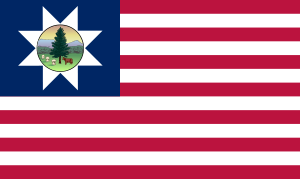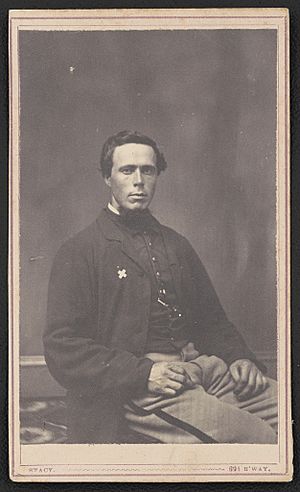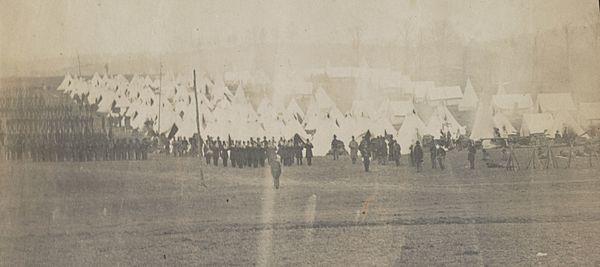4th Vermont Infantry Regiment facts for kids
Quick facts for kids 4th Vermont Infantry Regiment |
|
|---|---|

Flag of Vermont, 1837–1923
|
|
| Active | September 21, 1861 to July 13, 1865 |
| Allegiance | Union |
| Branch | United States Army Union Army |
| Type | Infantry |
| Size | 1,658 |
| Engagements | Battle of Williamsburg Battle of Savage's Station Battle of Antietam Battle of Fredericksburg Battle of Chancellorsville Second Battle of Fredericksburg Battle of Salem Church Battle of Gettysburg Battle of the Wilderness Battle of Spotsylvania Court House Battle of Cold Harbor Siege of Petersburg |
| Disbanded | July 13, 1865 |
| Commanders | |
| Colonel | Edwin H. Stoughton |
| Colonel | Charles B. Stoughton] |
| Colonel | George P. Foster |
| Insignia | |
| 2nd Brigade (Vermont Brigade), 2nd Division, VI Corps (Union Army), Army of the Potomac/Army of the Shenandoah (Union) |  |

The 4th Vermont Infantry Regiment was a group of soldiers who served in the Union Army during the American Civil War. They were an infantry regiment, meaning they fought on foot. They served for three years, from September 1861 to July 1865.
This regiment was part of the Union Army's main fighting force in the East, called the Army of the Potomac. They were also a key part of the famous Vermont Brigade, a group of regiments from Vermont known for their bravery.
Contents
The 4th Vermont Infantry: A Brief History
Joining the Fight
In July 1861, the U.S. government asked for 500,000 men to join the army for three years. The 4th Vermont Infantry was one of the regiments formed because of this call. Most of its soldiers came from the eastern part of Vermont.
The first choice for the regiment's leader, Lt. Col. Peter T. Washburn, couldn't take the job due to health issues. So, President Lincoln chose Edwin H. Stoughton, a young officer from the U.S. Military Academy. His younger brother, Charles B. Stoughton, also joined as an adjutant (an officer who helps with administration).
Getting Ready for War
The regiment gathered in Brattleboro by September 14, 1861, at a place called "Camp Holbrook." On September 21, 1048 men officially joined the Federal service. They left Vermont that same evening and arrived in Washington, D.C. on September 23.
A few days later, they marched to the Chain Bridge and joined other Vermont regiments: the 2nd, 3rd, and 5th. On October 9, all these Vermont regiments moved to Camp Griffin. Here, the 6th Vermont Infantry arrived on October 24, completing the group known as the "Old Vermont Brigade."
Changes in Leadership
Over time, some leaders of the regiment changed. In January 1862, Edwin H. Stoughton's brother, Charles Stoughton, became lieutenant colonel. Later, Edwin Stoughton was promoted to brigadier general in November 1862. Charles Stoughton then became the Colonel (the main leader) of the regiment.
After Charles Stoughton was injured and had to leave, George P. Foster became the final commander of the regiment. Both Charles Stoughton and George Foster were later recognized for their brave service.
A Difficult Day: Weldon Railroad
On June 23, 1864, the regiment faced one of its toughest days. They were fighting near the Weldon Railroad when enemy forces broke through their lines. Many soldiers, including seven officers and 137 men from the 4th Vermont, were surrounded and captured.
However, the regiment's flag was saved by the quick actions of the color guard (the soldiers who carry the flag). One brave officer, Captain William C. Tracy, was killed in this battle. His body was found surrounded by his men's muskets, showing they fought until their leader fell.
The End of Their Service
The soldiers who had joined at the beginning and did not choose to stay longer left the service on September 30, 1864. Other groups of soldiers joined the regiment later. Finally, the remaining officers and men of the 4th Vermont Infantry Regiment officially left the service on July 13, 1865.
Heroes of the 4th Vermont
Six members of the 4th Vermont Infantry Regiment were awarded the Medal of Honor, which is the highest military award for bravery. Here are some of their stories:
- Alexander M. Beattie, a Captain, bravely moved a wounded soldier to safety while under heavy enemy fire at the Battle of Cold Harbor on June 5, 1864.
- Robert J. Coffey, a Sergeant, single-handedly captured two officers and five soldiers from the enemy's 8th Louisiana Regiment at the Battle of Salem Church on May 4, 1863.
- James Drury, a Sergeant, saved his regiment's flag when they were surrounded by a much larger enemy force at Weldon Railroad on July 23, 1864. Most of his regiment had been killed or captured, but he saved the flag.
- George W. Hooker, a 1st Lieutenant, rode alone into enemy lines ahead of his regiment. Before his own men arrived, he managed to get a Confederate major, his flag, and 116 men to surrender at the Battle of South Mountain on September 14, 1862.
- Carlos H. Rich, a 1st Sergeant, saved the life of an officer at the Battle of the Wilderness on May 5, 1864.
- Daniel D. Wheeler, a 1st Lieutenant, showed great bravery in battle at the Battle of Salem Church on May 3, 1863. He was wounded, and his horse was shot from under him during the fight.
Key Battles and Engagements
The 4th Vermont Infantry Regiment fought in many important battles during the Civil War. Here is a list of some of their major engagements:
| ENGAGEMENTS | |
|---|---|
| Battle of Lewinsville | September 11, 1861 |
| Battle at Lee's Mills | April 16, 1862 |
| Battle of Williamsburg | May 5, 1862 |
| Battle of Garnett's & Golding's Farm | June 26, 1862 |
| Battle of Savage's Station | June 29, 1862 |
| Battle of White Oak Swamp | June 30, 1862 |
| Battle of Crampton's Gap | September 14, 1862 |
| Battle of Antietam | September 17, 1862 |
| Battle of Fredericksburg | December 13, 1862 |
| Battle of Marye's Heights | May 3, 1863 |
| Battle of Salem Church | May 4, 1863 |
| Second Battle of Fredericksburg | June 5, 1863 |
| Battle of Gettysburg | July 3, 1863 |
| Battle of Funkstown | July 10, 1863 |
| Battle of Rappahannock Station | November 7, 1863 |
| Battle of the Wilderness | May 5–10, 1864 |
| Battle of Spotsylvania | May 10-18, 1864 |
| Battle of Cold Harbor | June 1-12, 1864 |
| Battle of Petersburg | June 18, 1864 |
| Battle of Reams' Station | June 29, 1864 |
| Fort Stevens (Washington, D.C.) | July 11, 1864 |
| Battle of Charlestown | August 21, 1864 |
| Battle of Opequon (Gilbert's Ford) | September 13, 1864 |
| Battle of Winchester (Opequon) | September 19, 1864 |
| Battle of Fisher's Hill | September 21-22, 1864 |
| Battle of Cedar Creek | October 19, 1864 |
| Battle of Petersburg | March 25, 1865 |
| Battle of Petersburg | April 2, 1865 |
The Regiment's Numbers
The 4th Vermont Infantry Regiment started with 1048 soldiers. Over time, 642 more soldiers joined them, making a total of 1690 people who served in the regiment.
Sadly, many soldiers were lost during the war:
- 86 soldiers were killed in action during battles.
- 73 soldiers died later from their wounds.
- 201 soldiers died from diseases, which was a common cause of death in the Civil War.
- 61 soldiers died while held in Confederate prisons.
- 2 soldiers died from accidents.
In total, 423 soldiers from the 4th Vermont Infantry Regiment died during their service.
Many others were wounded (418) or taken prisoner (199). At the end of the war, 583 soldiers were officially discharged from service.


